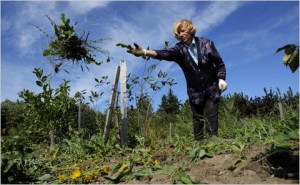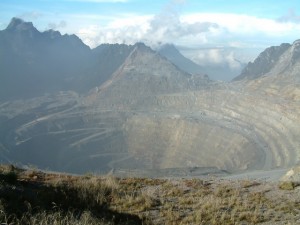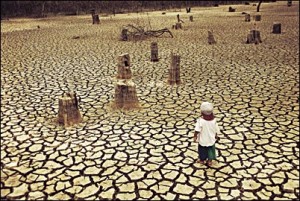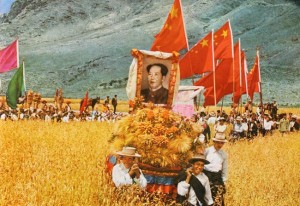Traditional Food, Medicine & Biodiversity

The N.I. Vavilov Institute of Plant Industry
Nikolai Ivanovich Vavilov (Russian: Николай Иванович Вавилов) was a prominent Russian and Soviet botanist and geneticist best known for having identified the centres of origin of cultivated plants. He devoted his life to the study and improvement of wheat, corn, and other cereal crops that sustain the global population. While developing his theory on the centres of origin of cultivated plants, Vavilov organized a series of botanical-agronomic expeditions, collected seeds from every corner of the globe, and created in Leningrad the world’s largest collection of plant seeds. Read More: > HERE <
The Convention on Biological Diversity (CBD), known informally as the Biodiversity Convention, is an international legally binding treaty. The Convention has three main goals: 1. conservation of biological diversity (or biodiversity);2. sustainable use of its components; and 3. fair and equitable sharing of benefits arising from genetic resources. In other words, its objective is to develop national strategies for the conservation and sustainable use of biological diversity. It is often seen as the key document regarding sustainable development. Read More: >HERE<
Ensuring that the genetic diversity of the world’s food crops is preserved for future generations is an important contribution toward the reduction of hunger and poverty in developing countries. This is where the greatest plant diversity originates and where the need for food security and the further development of agriculture is most urgent.
About VIR: “The scientific network of VIR includes the institute’s headquarters with 9 plant resources departments, 13 fundamental research laboratories, and 12 experiment stations in different geographic zones of Russia. Its chief activities are Plant Genetics Resources (PGR) collections, conservation and study.”
This recent news item was originally reported on Science Magazine’s Science Insider news feed. Earlier reportage on this story came from The Scientist blog. Top Photo: Alaska wild “berries” from the Innoko National Wildlife Refuge; U.S. Fish and Wildlife Service employee (public domain). Bottom Photo: VIR, Pavlosk Exp. Station http://www.greendump.net
Last week, we described the plight of the Russian Pavlovsk Experimental Station: Plans for a housing complex threaten some 5,000 rare plants, including varieties found nowhere else on the planet. A court judgment last week meant that only the president or prime minister could save the plants, which scientists said would take years to relocate. Now government telegrams and a presidential tweet hint that the plants might have a chance. http://blogs.discovermagazine.com
Russia Defers Razing of Seed Repository – modest reprieve for a seed bank that is home to the world’s largest collection of European fruits and berries. http://green.blogs.nytimes.com
The Vavilov Institute in Russia is the oldest seed bank in the world with a collection of over 325,000 samples of seed. Video from The Vavilov Institute from The Seed Hunter on National Geographic Channel http://natgeotv.com
Vavilov Institut Alblinse, Russian Housing Plan Threatens Seed Bank
The Institute of Plant Industry http://www.vir.nw.ru/ was established in 1921. Nikolai Vavilov was the head of this institute from 1924 to 1936 and had, and still has, the world’s largest collection of plant seeds. During the early 1930s, he became the target of the Lysenkoist debate and was exiled. In 2010 the plant collection at the Pavlovsk Experimental Station was to be destroyed to make way for luxury housing
IRRI http://irri.org Rice Research is a nonprofit research and education center established to reduce poverty and hunger, improve the health of rice farmers and consumers, and ensure environmental sustainability
Navdanya http://www.navdanya.org is a network of seed keepers and organic producers spread across 16 states in India.Navdanya has helped set up 54 community seed banks across the country, trained over 500,000 farmers in seed sovereignty, food sovereignty and sustainable agriculture over the past two decades, and helped setup the largest direct marketing, fair trade organic network in the country.
ARCHE NOAH: http://www.arche-noah.at Wir sehen unsere Arbeit als Antwort auf die restriktive globale Saatgutpolitik. Die Vielfalt an Kulturpflanzen ist Lebensgrundlage für kommenden Generationen. Und Lebensqualität für uns alle ! Wir sind ein Verein, der sich seit fast 20 Jahren für den Erhalt alter Kulturpflanzen einsetzt, mit über 8.000 Mitgliedern, Förderern und aktiven ErhalterInnen.
Svalbard Global Seed Vault – Cultural plants for the future. http://www.regjeringen.no Since the climate conditions change so rapidly, it is extremely important to ensure the genetic diversity of all the cultural plants of the world. In these genes, we will find the necessary qualities to make effective cultural plants in the future. This is absolutely necessary to secure a satisfactory food supply for the global population. Within the next 40 years, the world’s food production must be doubled, says the Norwegian minister of agriculture and food, Lars Peder Brekk.
Was wären die Schwaben ohne ihre Linsen? Trotzdem stellten Ende der 50er Jahre die letzten Landwirte “auf der Alb” den Anbau von Linsen ein, da die Importe zu billig waren und den Verbrauchern egal war, woher ihre Linsen kamen. Im Pflanzenbau herrschte damals der Zeitgeist “höher, schneller und immer mehr”. Hauptsache, der Ertrag von Weizen, Mais und Kartoffeln stieg. Egal, wie viel “Chemie” dazu auf den Acker kam. Diese Ideologie war den hiesigen Bio-Bauern schon immer ein Dorn im Auge.
Außerdem vermissten sie ihre Heimatfrucht aus der Kindheit: “Die alten Bauern bei uns in der Gegend haben uns erzählt, wie sie noch Linsen angebaut haben, zusammen mit Gerste ( GERSTE IM AYURVEDA ) und Hafer, als Stützfrucht für die zarten Pflanzen. Beim Linsen essen haben wir davon geträumt, wieder Alb-Linsen auszusäen”, erinnert sich Woldemar Mammel. Der Bioland-Bauer aus Lauterach auf der Alb baut bereits seit den 80er Jahren wieder Linsen an und begeisterte auch andere für seine Idee. Mittlerweile machen elf Bäuerinnen und Bauern in der “Öko-Erzeugergemeinschaft «Alb-Leisa»” mit und bewirtschaften 30 Hektar mit Albleisen.
Unterstützung bekommen sie von anderen Verfechtern guter Esskultur: Vor zwei Jahren hat Slow Food Deutschland die Alb-Linse in die “Arche des Geschmacks” aufgenommen, um dieses traditionelle landwirtschaftliche Erzeugnis der Schwäbischen Alb vor dem Vergessen zu retten. Die Sache hat nur einen Haken: Die original schwäbischen Alb-Linsen waren bis vor kurzem unauffindbar und so mussten sich die Bio-Bauern mit französischen und italienischen Sorten behelfen. “Niemand hatte es für nötig gehalten, diese einzigartigen, im Bundessortenregister eingetragenen Linsensorten aufzubewahren”, beklagt Mammel.
Doch die verschollenen Linsen berührten auch andere schwäbische Herzen: 2006 machten sich unabhängig voneinander der private Pflanzenzüchter Klaus Lang und Klaus Amler von der Stuttgarter Agentur Ökonsult auf die Suche. Beide werden ein Jahr später in Russland fündig! Das Wawilow-Institut in St. Petersburg, das seit 1925 für die Genvielfalt der Nutzpflanzen kämpft, hat die zwei Sorten aufbewahrt.
RICE: Rice is first mentioned in the Yajur Veda (c. 1500-800 BC) and then is frequently referred to in Sanskrit texts. Today, the majority of all rice produced comes from India, China, Japan, Indonesia, Thailand, Burma, and Bangladesh.
Asian farmers still account for 92-percent of the world’s total rice production. Rice is grown in all parts of India. Genetics shows that rice was first domesticated in the region of the Yangtze River Valley. Read More: > HERE <
- www.pranapositive.com/shm/Save Herbal Medicine
- Articles on Biodiversity
- IRRI Rice Research/Climate Change /Bioversity/Eco Crises
- www.intlcss.org International Crop Science Society
- ARCHE NOAH, Erhaltung/Verbreitung Kulturpflanzenvielfalt
- Meet UN International Day 2010 of Biodiversity at fb
- Meet Global Biodiversity Protection at fb
- www.ienearth.org Indigenous Environmental Network at fb
- www.navdanya.org studies friends fans at fb
- www.ecobuddhism, friends and studies at fb
- Greenpeace China 绿色和平 綠色和平 at fb
- Meet SLOW FOOD , friends, pages at fb
- Meet TIBETAN TSAMPA Group and Friends at fb
- http://en.wikipedia.org/wiki/Farmers’_suicides_in_India
- http://en.wikipedia.org/wiki/Europ.Directive Trad.Herbal_Med.Products
- Meet COP 16 UN Conference, friends, studies, fans at fb
- Meet International Year of Biodiversity, friends, fans at fb
- Meet NaturalNews.com at facebook
NaturalNews.com is an independent news resource that covers the natural health and wellness topics that empower individuals to make positive changes in their personal health. NaturalNews offers uncensored news that allows for healthier choice.
The variety of life on Earth, its biological diversity is commonly referred to as biodiversity.The number of species of plants, animals, and microorganisms, the enormous diversity of genes in these species, the different ecosystems on the planet, such as deserts, rainforests and coral reefs are all part of a biologically diverse Earth. Appropriate conservation and sustainable development strategies attempt to recognize this as being integral to any approach. Almost all cultures have in some way or form recognized the importance that nature, and its biological diversity has had upon them and the need to maintain it. Yet, power, greed and politics have affected the precarious balance. http://www.globalissues.org/biodiversity
His Holiness the Dalai Lama speaks to the Canada Tibet Committee about the effects of climate change in the Tibetan Plateau. Glaciers in Tibet are melting at a rate faster than anywhere else in the world and this has a direct impact on river flows, natural hazards, the ecosystem. www.tibet.ca
Tsampa (Tibetan: རྩམ་པ་; Wylie: rtsam pa) is a Tibetan staple foodstuff, particularly prominent in the central part of the country. It is roasted flour, usually barley flour (Tibetan: ནས་རྩམ་; Wylie: nas rtsam) and sometimes also wheat flour (Tibetan: གྲོ་རྩམ་; Wylie: gro rtsam) or rice flour (Tibetan: འབྲས་རྩམ་; Wylie: bras rtsam). It is usually mixed with the salty Tibetan butter tea (Tibetan: བོད་ཇ་; Wylie: bod cha).
Tsampa is the staple food of Tibetans and often called as the National food of Tibet. Read More Here

With one-fifth of the world’s population relying on seasonal Himalayan melting, the disappearance of the Third Pole is sending warning signs.
Floods, droughts, wildfires, windstorms, water contamination and illnesses plague the 1.3 billion people who live in the watersheds directly supplied by glacial melt from the Hindu Kush-Himalaya (HKH) region.
The waterways of Afghanistan, Bangladesh, Bhutan, China, India, Myanmar, Nepal, and Pakistan are endangered, and scientists are gaining a bettter understanding of just how fast climate change is taking its toll on the region.
As the Himalayan glaciers disappear, ten major Asian river systems–the Amu Darya, Indus, Ganges, Brahmaputra, Irrawaddy, Salween, Mekong, Yangtse, Yellow, and Tarim–are threatened. Twenty percent of the world’s population faces a future of catastrophe, according to a report released by University College, Chinadialogue, and King’s College of London in May 2010.
Extreme glacial melt, seismic activity and extreme weather events are already affecting the region’s rivers, lakes, wetlands and coasts. The devastation is a warning sign of what’s to come.
In these feature articles, news briefs, photographs, and graphics Circle of Blue documents one of the critical front lines in the global battle against climate change and water scarcity.

ABOUT the INDIGENOUS ENVIRONMENTAL NETWORK – Established in 1990 within the United States, IEN was formed by grassroots Indigenous peoples and individuals to address environmental and economic justice issues (EJ). IEN’s activities include building the capacity of Indigenous communities and tribal governments to develop mechanisms to protect our sacred sites, land, water, air, natural resources, health of both our people and all living things, and to build economically sustainable communities.IEN accomplishes this by maintaining an informational clearinghouse, organizing campaigns, direct actions and public awareness, building the capacity of community and tribes to address EJ issues, development of initiatives to impact policy, and building alliances among Indigenous communities, tribes, inter-tribal and Indigenous organizations, people-of-color/ethnic organizations, faith-based and women groups, youth, labor, environmental organizations and others. IEN convenes local, regional and national meetings on environmental and economic justice issues, and provides support, resources and referral to Indigenous communities and youth throughout primarily North America – and in recent years – globally.

http://en.wikipedia.org/wiki/Grasberg_mine
www.frackaction.com (Water for 15 Mio.)

www.illegal-logging.info www.emagazine.com
-
In these feature articles, news briefs, photographs, and graphics Circle of Blue documents one of the critical front lines in the global battle against climate change and water scarcity:
-
Arctic Now Traps 25 Percent of World’s Carbon — But That Could Change
http://www.usgs.gov/newsroom/article.asp?ID=2326&from=rss -
Any action on climate change will affect international trade obligations that bind the U.S. and more than 150 other members of the World Trade Organization.
-
Methane releases from Arctic shelf may be much larger and faster than anticipated.A section of the Arctic Ocean seafloor that holds vast stores of frozen methane is showing signs of instability and widespread venting of the powerful greenhouse gas, according to new research.

Mao’s Tibet Disaster – In 1959, in Tibet after the Dalai Lama fled to India, the Chinese enforced new approaches to agriculture. They started up communes on a mass scale, and ordered wheat to be planted instead of barley. No arable land was to be left idle: teams embarked on massive irrigation projects, built dams and reservoirs, and collected waste matter for fertiliser. Propaganda posters from the 1960s show happy smiling Tibetans with bumper harvests—enthusiastically parading around wheatfields with Mao Zedong pictures.
But the reality was very different: tens of thousands of Tibetans starved to death. China’s disastrous agricultural policies led to severe famine in Tibet. No sooner was Tibet’s crop harvested than it was taken by the army or shipped to China. The whole intent of forming communes was to create a bread-basket for the starving People’s Republic, which was suffering its own famine—due to similar disastrous policies.
Comments are closed.